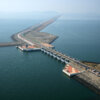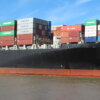Dredging is the foundation of almost all maritime infrastructure projects and addresses a broad range of society’s economic, social and environmental needs.
Waterborne transport
Waterborne transport has been proven time and time again to be economically viable and environmentally preferable to overland transport. Nonetheless, few ports are naturally deep and most modern ports, given the increasing size of container vessels, require investment in capital dredging. Access channels and turning basins need to be dredged to provide appropriate water depths along waterside facilities. Once established, these waterways continue to require regular maintenance dredging.
Population growth
Worldwide population growth also contributes to the increased demand for dredging. About half the world’s population lives within 200 kilometres of a coastline and climate change has increased the risk of flooding and vulnerability of these populations. Ironically this means that both coastal development and coastal protection are necessities.
Coastal development
According to the United Nations Department of Economic and Social Affairs (UN DESA), the current world population of 7.3 billion is expected to reach 8.5 billion by 2030 and to reach 9.7 billion by 2050. This coastal urbanisation creates a need for more land for residential, employment and recreational facilities. Innovative dredging technologies have made it feasible to reclaim sand to build new land adjacent to existing urban areas or islands near the coast at reasonable cost.
Coastal protection
More people living along the coast also means increased vulnerability for human life and property. Dredging also meets the demand of coastal populations for more beach protection against floods and other health and safety concerns.
Economic growth
These demographic developments are having an impact on the need for goods and services. In addition to the economic growth purely based on the increase in population, an additional increase in the Gross Domestic Product (GDP) per capita is predicted over the next few decades for many countries. This economic boost is the result of further globalisation of markets and to the opening of formerly closed markets by new trade agreements.
Generally speaking, Brazil, Russia, India and China (the BRIC nations) have adjusted their political systems to embrace some aspects of capitalism. China and India, respectively, are dominant global suppliers of manufactured goods and services, while Brazil and Russia are dominant as suppliers of raw materials. Much of this new trade will be delivered by waterborne transportation and this increase in waterborne trade requires improvements and expansion of ports and harbours.
Offshore energy
The search for offshore energy sources, first gas and oil, and presently the placement of windmills at sea, has spurred growth in the dredging industry. Levelling the seabed and laying cables, backfilling and rock placement have demanded new areas of expertise.
related
Articles
Evaluation of a nature-based agitation dredging solution

The challenge of maintaining harbours and ports while conserving and sustaining coastal habitats, with all the rich resources they provide, requires that port and harbours do more to develop approaches to maintenance dredging that provide benefit to these neighbouring habitats. In this article, we describe an example from Harwich Harbour in the UK where Harwich Haven Authority (the Conservancy Authority) is looking to move to a more nature-based maintenance dredging methodology, using agitation dredging. Using the results of monitoring and sophisticated numerical modelling, we evaluate the likely benefit to the Stour/Orwell intertidal areas arising from the use of the agitation dredging.
Publications
Paper: Reclamation Pays – Assessing the Socio-Economic effects of Reclamation projects

This paper was written by Marco Gatto, 2 November 2014. The aim of this article is to contribute to a better understanding of the different types of socio-economic effects produced by reclamation projects, and hence to a more appropriate assessment of the overall value of reclamation based investments. Port cities have long been struggling to accommodate urban growth, given the difficulties of finding space within ge
Videos
Presentation: ‘Sand as a Resource’ by Jan Fordeyn (Jan De Nul) − Director Project Development & Conceptual Design

In our day to day lives most of us are not aware of how many industries rely on sand as a part of their working process. The amount of sand consumed has dramatically increased over the last few years and this can be largely contributed to the world wide construction boom. How is this going to affect us in the future?














